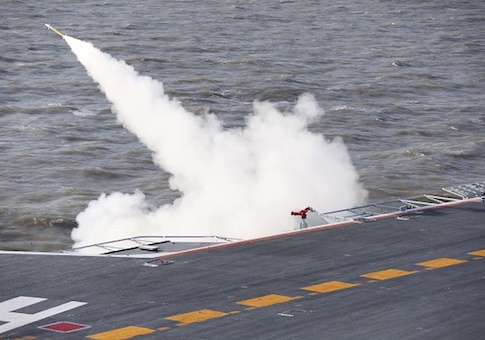China achieved a breakthrough development for high-speed missiles equipped with a new high-technology ramjet engine, according to state media.
The breakthrough was based on two successful flight tests of a solid-fuel ramjet capable of producing hypersonic speeds—4,000 miles per hour or faster, according to a May 31 report in Science and Technology Daily, official newspaper of the Chinese Ministry of Science and Technology.
The new engine is part of China's second type of hypersonic missile—weapons designed to defeat missile defenses.
The first hypersonic weapon, known as the DF-ZF, is a strike vehicle that glides and maneuvers to its target at speeds of up to 7,000 miles per hour. China has conducted six tests of the DF-ZF, according to Pentagon officials.
A ramjet is a high-speed engine that must be launched from missiles or aircraft that then accelerates. It is designed to use its forward propulsion to assist efficient fuel combustion in producing hypersonic speeds.
Hypersonic weapons are deadlier than slower missiles because of the ability to maneuver at very high speeds, making detection, tracking, and targeting by missile defense sensors and interceptors very difficult.
China's hypersonic weapons, which have been in development for more than a decade, were mentioned Monday by Marine Corps Gen. Joseph Dunford, chairman of the Joint Chiefs of Staff, as one of the several growing threats posed by China's military.
Dunford said during congressional testimony that the Chinese "have expanded their nuclear enterprise and made investments in power projection, space, cyber, hypersonic weapons, cruise missiles, and ballistic missiles—even as they continue to build out their physical presence in the South China Sea."
It was the first time the chairman mentioned hypersonic weapons in discussing military challenges from China.
Defense Secretary Jim Mattis also voiced concerns about growing hypersonic missile threats during a House Armed Services Committee hearing Monday night.
Asked about Russia's recent test of a Zircon hypersonic cruise missile and Chinese hypersonic missiles, Mattis said the weapons represent one of the new dangers posed by rapid technological change. "I think we have got to increase our hypersonic R&D effort," he said.
The Washington Free Beacon first reported Chinese development of a new ramjet powered hypersonic missile in 2014. The report included a drawing of the missile.
According to recent Chinese reports, the new ramjet engine involves a variable airflow and is expected to enhance missiles carried by China's J-20 fighter, as well as hypersonic missiles.
The technology breakthrough was made by a research team from the No. 4 Research Institute under the China Aerospace Science and Technology Corporation.
Based on the two successful flight tests, development of the ramjet will advance to the next phase of engineering, "paving the way for China's next generation of hypersonic missiles," Science and Technology Daily reported.
The engine has been under development since 2000 and was described as a low-cost, high power, and high controllability propulsion system in a compact form. A total of eight flight tests have been carried out.
Song Zhongping, a military expert formerly with the People's Liberation Army Rocket Force, told the Global Times that the new engine will give J-20 jets the ability to fire missiles to great ranges and at hypersonic speeds.
Ramjet-powered anti-aircraft missiles will have ranges of up to 186 miles at speeds faster than Mach 5, or more than 4,000 miles per hour.
The engine likely will be deployed with China's more advanced missiles including the PL-12 air-to-air missile, which currently has a range of 62 miles.
Hypersonic missiles cannot be countered by U.S. missile defenses because of their extremely high speeds.
Future uses include development of ramjet-powered cruise missiles and unmanned aircraft.
The Pentagon's annual report on China's military said hypersonic weapons are one of several arms that Beijing is investing significant resources in developing.
The weapons are being developed to counter U.S. ballistic missile defenses, the report said.
An Air Force-sponsored study made public last year warned that the United States is facing a growing threat of attack from hypersonic missiles.
"The People's Republic of China and the Russian Federation are already flight-testing high-speed maneuvering weapons (HSMWs) that may endanger both forward deployed U.S. forces and even the continental United States itself," an executive summary of the report stated.
"These weapons appear to operate in regimes of speed and altitude, with maneuverability that could frustrate existing missile defense constructs and weapon capabilities."
Gen. Mark Milley, Army chief of staff, told a Senate hearing June 7 that the service and the Pentagon are "progressing on the development of hypersonic munitions."
"Not only missiles, but bullets as well," Milley said, adding that funds are being devoted to research and development.
The budget request for fiscal 2018 contains $75 million for software modification to current ballistic missile defenses to deal with hypersonic threats.
